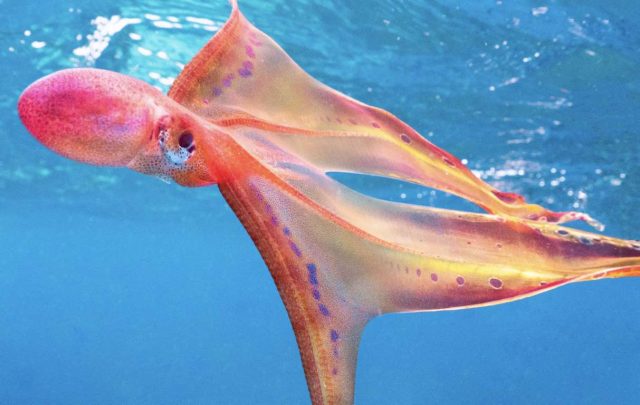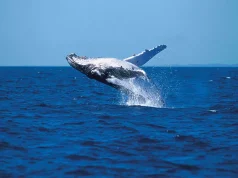
Master Reef Guide and Marine Biologist, Jacinta Shackleton, has kicked off the new year with a once-in a-lifetime experience, coming face to face with a rare Blanket Octopus in waters off Lady Elliot Island on 6 January 2022.
Ms Shackleton has been conducting research and diving the reef around Lady Elliot Island on Queensland’s Southern Great Barrier Reef for almost four years and has never come across the technicoloured marine mollusc before – demonstrating the rarity of its sighting.
“I was snorkelling about 100m off the shore with a friend, in about eight or nine metres of water, when I saw this rainbow-coloured flicker,” Ms Shackleton said.
“When I first saw it, I thought it could have been a juvenile fish with long fins, but as it came closer, I realised it was a female Blanket Octopus and I had this overwhelming sense of joy and excitement.
“I kept yelling through my snorkel, ‘it’s a Blanket Octopus!’ I was so excited I was finding it difficult to hold my breath to dive down and video it.
“Seeing one in real life is indescribable, I was so captivated by its movements, it was as if it was dancing through the water with a flowing cape. The vibrant colours are just so incredible, you can’t take your eyes off it.
“I’ve truly never seen anything like it before and don’t think I ever will again in my life.”
A paper by Museums Victoria Senior Curator for Marine Invertebrates, Dr Julian Finn, and colleagues, states that sightings of this species are so rare the first live male was spotted just 21 years ago on the Ribbon Reefs further north on Great Barrier Reef. While Ms Shackleton believes there to be only three other sightings of the Blanket Octopus at Lady Elliot Island before her own encounter.
A fascinating fact about this species is that the female Blanket Octopus can grow to between one and two metres in length, whereas males grow to around 2.4cm, meaning this species has the largest gender size discrepancy in the marine world. The name ‘Blanket Octopus’ comes from the webbed ‘cape’ or ‘blanket’ that trails behind the female, a feature the males do not display.
Further, the female Blanket Octopus can shed her distinctive fluorescent coloured cape in self-defence, and the species can take stinging cells from other organisms to use as a weapon.
Ms Shackleton said that the Blanket Octopus generally spend its lifecycle in the open ocean so it’s even more unusual to see one on the reef. She feels lucky and grateful to have been in the water at the right time to capture such vivid vision of the spectacular species.
“A lot of images you’ll see are of individuals in captivity or at night, so I’m very lucky to have seen one during the day, in the wild, and to have had two cameras with me at the time,” Ms Shackleton said.
“This day has got to be one of my all-time favourite reef experiences, and I’m already planning to blow up some large-scale prints to hang in my house to celebrate the moment.”
This is not Ms Shackleton’s first extraordinary sighting off Lady Elliot Island having encountered a rare Ornate Eagle Ray in 2020, a fever of more than 100 distinctive Cownose Rays in 2021 and a rare melanistic manta ray also in 2021.
Lady Elliot Island is home to an abundance of vibrant marine life, making it one of the most sought-after destinations for a once-in-a-lifetime Great Barrier Reef experience. Ocean-lovers can find out more about this World Heritage wonderland at queensland.com/greatbarrierreef.





